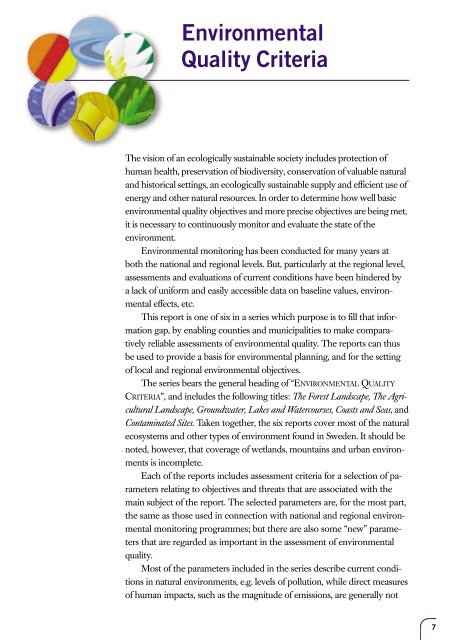Lakes and Watercourses
Lakes and Watercourses Lakes and Watercourses
Environmental Quality Criteria The vision of an ecologically sustainable society includes protection of human health, preservation of biodiversity, conservation of valuable natural and historical settings, an ecologically sustainable supply and efficient use of energy and other natural resources. In order to determine how well basic environmental quality objectives and more precise objectives are being met, it is necessary to continuously monitor and evaluate the state of the environment. Environmental monitoring has been conducted for many years at both the national and regional levels. But, particularly at the regional level, assessments and evaluations of current conditions have been hindered by a lack of uniform and easily accessible data on baseline values, environmental effects, etc. This report is one of six in a series which purpose is to fill that information gap, by enabling counties and municipalities to make comparatively reliable assessments of environmental quality. The reports can thus be used to provide a basis for environmental planning, and for the setting of local and regional environmental objectives. The series bears the general heading of “ENVIRONMENTAL QUALITY CRITERIA”, and includes the following titles: The Forest Landscape, The Agricultural Landscape, Groundwater, Lakes and Watercourses, Coasts and Seas, and Contaminated Sites. Taken together, the six reports cover most of the natural ecosystems and other types of environment found in Sweden. It should be noted, however, that coverage of wetlands, mountains and urban environments is incomplete. Each of the reports includes assessment criteria for a selection of parameters relating to objectives and threats that are associated with the main subject of the report. The selected parameters are, for the most part, the same as those used in connection with national and regional environmental monitoring programmes; but there are also some “new” parameters that are regarded as important in the assessment of environmental quality. Most of the parameters included in the series describe current conditions in natural environments, e.g. levels of pollution, while direct measures of human impacts, such as the magnitude of emissions, are generally not 7
- Page 1 and 2: Environmental Quality Criteria - La
- Page 3 and 4: TO ORDER Swedish Environmental Prot
- Page 5 and 6: Reference Group Mats Bengtsson, Swe
- Page 7: Summary This report on lakes and wa
- Page 12 and 13: Internationally, the most widely ac
- Page 14 and 15: Environmental Quality Criteria for
- Page 16 and 17: TABLE 1. Continued Area/parameter L
- Page 18 and 19: y the environmental quality aspects
- Page 20 and 21: Nutrients / eutrophication Introduc
- Page 22 and 23: concentrations. Using accepted term
- Page 24 and 25: from fields in lowland areas and cl
- Page 26 and 27: This classification is based on an
- Page 28 and 29: TP ref (kg P/ha, year) = 0.002 · x
- Page 30 and 31: Oxygen status and oxygen-consuming
- Page 32 and 33: In lakes, seasonal mean values for
- Page 34 and 35: used to estimate the distribution o
- Page 36 and 37: In lakes, Secchi depth is classifie
- Page 38 and 39: Assessment of current conditions Ac
- Page 40 and 41: The concentration of base cations i
- Page 42 and 43: Metals Introduction Metals occur na
- Page 44 and 45: Class 1. No or only very slight ris
- Page 46 and 47: of present concentrations in Sweden
- Page 48 and 49: Class 1. No or insignificant impact
- Page 50 and 51: Assessment of mercury in fish shoul
- Page 52 and 53: Phytoplankton in lakes Introduction
- Page 54 and 55: Chlorophyll-a concentrations refer
- Page 56 and 57: ately eutrophic lakes. To classify
Environmental<br />
Quality Criteria<br />
The vision of an ecologically sustainable society includes protection of<br />
human health, preservation of biodiversity, conservation of valuable natural<br />
<strong>and</strong> historical settings, an ecologically sustainable supply <strong>and</strong> efficient use of<br />
energy <strong>and</strong> other natural resources. In order to determine how well basic<br />
environmental quality objectives <strong>and</strong> more precise objectives are being met,<br />
it is necessary to continuously monitor <strong>and</strong> evaluate the state of the<br />
environment.<br />
Environmental monitoring has been conducted for many years at<br />
both the national <strong>and</strong> regional levels. But, particularly at the regional level,<br />
assessments <strong>and</strong> evaluations of current conditions have been hindered by<br />
a lack of uniform <strong>and</strong> easily accessible data on baseline values, environmental<br />
effects, etc.<br />
This report is one of six in a series which purpose is to fill that information<br />
gap, by enabling counties <strong>and</strong> municipalities to make comparatively<br />
reliable assessments of environmental quality. The reports can thus<br />
be used to provide a basis for environmental planning, <strong>and</strong> for the setting<br />
of local <strong>and</strong> regional environmental objectives.<br />
The series bears the general heading of “ENVIRONMENTAL QUALITY<br />
CRITERIA”, <strong>and</strong> includes the following titles: The Forest L<strong>and</strong>scape, The Agricultural<br />
L<strong>and</strong>scape, Groundwater, <strong>Lakes</strong> <strong>and</strong> <strong>Watercourses</strong>, Coasts <strong>and</strong> Seas, <strong>and</strong><br />
Contaminated Sites. Taken together, the six reports cover most of the natural<br />
ecosystems <strong>and</strong> other types of environment found in Sweden. It should be<br />
noted, however, that coverage of wetl<strong>and</strong>s, mountains <strong>and</strong> urban environments<br />
is incomplete.<br />
Each of the reports includes assessment criteria for a selection of parameters<br />
relating to objectives <strong>and</strong> threats that are associated with the<br />
main subject of the report. The selected parameters are, for the most part,<br />
the same as those used in connection with national <strong>and</strong> regional environmental<br />
monitoring programmes; but there are also some “new” parameters<br />
that are regarded as important in the assessment of environmental<br />
quality.<br />
Most of the parameters included in the series describe current conditions<br />
in natural environments, e.g. levels of pollution, while direct measures<br />
of human impacts, such as the magnitude of emissions, are generally not<br />
7



